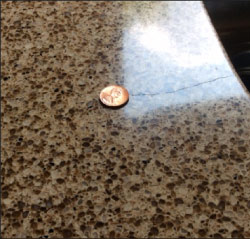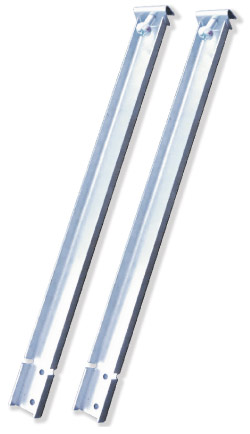Don’t Use Sink Clips on Solid Surface Tops
CaesarStone’s Brian Brutting Presents Some Best Practice Advice on Solid Surface Sink Installation
 |
|
A crack has started in this top using clips to support an undermount sink. The crack is visible just to the center right of the penny. |
 |
|
Products like the Sink Undermounter bars and Sinkits LC Brackets do not penetrate the top surface and will not lead to a fracture.
|
Are sink clips an outdated way to install sinks? The answer is “Yes,” says Brian Brutting, as far as Caesarstone and other quartz tops are concerned.
Brian Brutting is senior customer service and training specialist for Caesarstone USA.
“With the advent of so many new systems that are easier to use (like the SINK-IT LC system), they are more cost effective when you calculate your labor cost. Plus, there’s no risk of scratching or damaging the top, trying to drill or grind holes on the opposite side. Sinks installed with a rail system will never fail, if installed properly. But most importantly, in today’s world and the increased focus and concern of silicosis, why would you use any system that could create any stone dust, in the shop or a customer’s home?”
Brutting continued, “Another thought to consider is using on a drill or grinding system on a quartz top may lead to a crack. All engineered quartz expands and contracts, so whenever you use the old-fashioned clips, you create a tension point for potential failure (see photo at top right–can you spot the hairline crack?).
“I’m not saying drilling will always lead to a crack, but when you consider all the risks of old fashion clips, and all the benefits of rail style systems, it really and easy to choose.”
In his training classes, Brutting stress the importance of using non-mechanical rail type fasteners. “No matter what type of hard surface you use, old style clips systems simply fail over time; they don’t last as they should. Also, clip system can lead to pipe failure, cracks and leaks, because the clips simply can’t hold the weight of a full sink of water.
“In Quartz counter tops, clips create a void on the underside that can lead to a fracture, when the counter expands and contracts from heat. Even on natural stone, clips can rust, and the rust can cause the clip to break due to moisture absorbed through the porous stone.
“Rail style Systems provide stronger and quicker installation of sinks and are becoming the standard for all hard surfaces. For over 20 years, Caesarstone has prohibited the use of clips systems, knowing that it could cause premature failure of the clips and / or damaging the counters above. Rail system like the Sink LC are cost-effective, faster to install and safer, as there is no need to drill and create unnecessary stone dust. Most importantly, a rail system is the best method for quality craftsmanship.
“I have many friends in the industry, and over the years of spreading this message, they have all come around and changed over, saving tons of time and money. We at Caesarstone have recommended a rail system as an installer guideline, for years. The only systems that we approve attach to the cabinet, not the counter top. We feel so strongly of the benefits of not using sink clips that if the counter fails because of the use of a sink clips, it will have to be replaced at the fabricator’s expense.
“Caesarstone offers a lifetime warranty, so our guidelines are always ahead of the curve to ensure that our counters last the lifetime their owners expect.
For more information on these issues, contact Brian at Brian.Brutting@caesarstoneus.com.
You can also use Linkedin.com and search Brian Brutting Jr. for general industry questions.